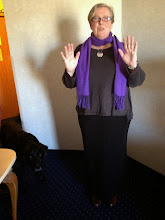At the grand finale of the 13th Annual International Festival of Arts and Ideas, the Liz Lerman Dance Exchange wrapped New Haven in a long white gown. Decorated her in strands of white prayer ties. Gathered up 13,000 prayers and flew them in the breeze. Made them into a dance.
Working with idea of democracy through dance, Lerman does these incredible community-based events with a cross-generational, multi-cultural troupe, asking four questions: Who gets to dance? Where is the dance happening? What is it about? Why does it matter? The productions are based on a multi-disciplinary definition of the artform that includes movement, imagery, spoken word and music.
The crowd has started gathering near the main stage, and Associate Artistic Director Elizabeth Johnson is warming us up by making us move. Hand out, arm up, sweep arms in a circle. Two new haven police on horses come through the crowd and make their way over to the Bennett Fountain (built in 1907), which has been marked off by a big circle of prayer ties strung together on the ground. She directs us to follow the horses, so everyone gets up and trots over to the fountain in the center of the green (originally known as "the marketplace," completed in 1638. The Puritans were said to have designed the green large enough to hold the number of people who they believed would be spared in the Second Coming of Christ: 100,000. Beginning on May Day, 1970, twelve thousand Black Panthers and their supporters arrived in New Haven individually and in organized groups. They were housed and fed by community organizations and Yale students in dormitories, and met en masse on the New Haven Green across the street from the Courthouse daily to hear protest speakers including Jean Genet, Benjamin Spock, Abbie Hoffman, Jerry Rubin, and John Froines. See Wikipedia!)
Dancers, dressed in white, start pouring out of the 3 three historic churches across the street (Trinity, United Church on Green (UCC), Center Church on the Green). The first group are in wheelchairs, a half a dozen motorized wheelchairs start circling the fountain. Real people in real wheel chairs, beaming. Then the roller-derby dancers that had performed earlier during the festival join in. A few bicycles start circling (new haven was the place where the first bicycle was ridden). Then parents and kids who had taken the parent/child dance workshops start circling, people are running and rolling up and down the paths. We're invited to move to this triangle edged in prayer ties. Pick up your chair and move. A parent/child dances ensues. Then we all migrate to the main stage.
There are video interviews on large screens on either side of the stage, people talking about the green. "I never go there past dark." "I love to come on my lunch break." The green as a picnic spot and barrier between yale and the rest of the city. A 15 year old mexican boy talks about the police coming to his house in the middle of the night last year and taking his parents away during a sweep on illegal immigrants. A 75 year old woman talks about the gestapo coming to her house in the middle of the night taking her whole family away, how the news of the illegal immigrant sweep in new haven affected her (pass the wine, wait, did you hear that?). The troupe teaches the crowd a dance--a prayer dance and story of new haven--simple, symbolic moves, includes circling your arms and holding yourself--Bobby Seale, making your demands known with two firm fists, drawing the past forward with a sweep of the arm. Everyone is up and writing the name of the person they are sending a prayer out to in the air with their fingers. Repeat. Repeat. The troupe--old young men women various colors--enter the stage, all in long white dresses reminiscent of wedding gowns. The local dancers re-join them, and together they do the new haven prayer dance one more time.
Who gets to dance? People in wheelchairs. Roller-derby queens. Bicyclists. Police on horses. Skateboarders. Parents and kids. Everybody in the crowd.
Where is the dance happening? The New Haven Green. The place where the first bicycle was ridden. Home of the homeless. Place for picnickers. A cut through on the way to work. Site of Black Panther rallies and church services, burials and free concerts, the making of art. A barrier between Yale and the rest of New Haven. Or is it a bridge?
What is it about? Beauty. Community. Inclusivity. Prayer. History. Cultures. Democracy.
Why does it matter? Like many cities, New Haven is stratified, with worlds orbiting around each other. It is home to one of the finest libraries in the world as well as neighborhoods with 75% unemployment. It was chopped up and separated from itself with the building of the interstate and the Oak Street connector in the late 1950s, obliterating neighborhoods, and leaving a physical divide that generations of planners and citizens have tried to redress.
 May Day celebration on New Haven Green, 2008.
May Day celebration on New Haven Green, 2008.Just found this blog, Design New Haven, "an open civic forum about Downtown New Haven, Connecticut. Our mission is to encourage community dialogue on topics including transportation, economic development, livable streets, history, downtown events, architecture/urban design, and the Route 34 Corridor."




No comments:
Post a Comment